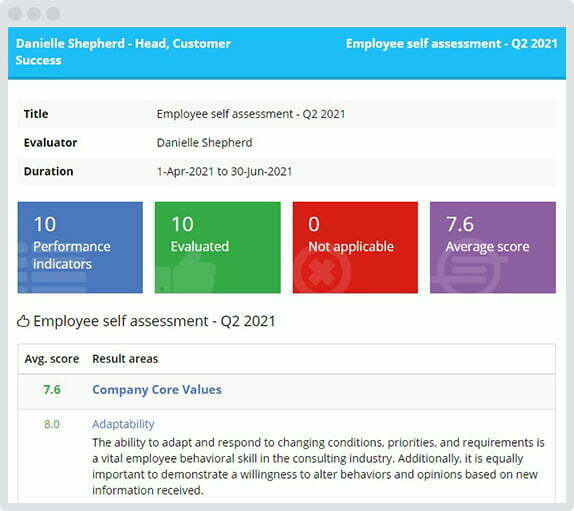One of the most powerful key performance indicators for your employee is their self-evaluation. When correctly done, a self-evaluation can make the appraisal process more effective, open up constructive communication between managers and employees, and provide several key benefits to the company.
While some may view employee self-evaluation as nothing more than a tedious step in the performance management process, it plays a crucial role that enriches the performance appraisal’s effectiveness. And, when effectively incorporated with internal strategies, self-evaluations can be extremely beneficial to organizational growth.
Benefits of Self-assessment
Active role
With the self-assessment, employees actively engage in the appraisal system, which turns them from being simply the ‘recipients’ of feedback to having their own voice, thereby; encouraging them to take a diligent part in shaping their performance appraisals as well as reviewing the process.
Gain a broader perspective
Self-assessment provides managers with a better insight into the employee’s overall performance and the perception of their own performance. At times, even after working closely with their subordinates, managers cannot always see the full picture. They are also not always able to correctly interpret the finer nuances that affect employee performance. With the self-evaluation process, managers can gain a broader perspective of the “hows” and “whys” of the employee’s performance.
Help identify the gaps
The information presented in the self-appraisals will guide managers during the employee performance evaluation process. This self-evaluation process helps identify gaps that otherwise might not have been found. Finally, it facilitates an open and constructive discussion between the employer and employee; thereby, improving the employee’s performance ratings.
Engage employees
Often, top-down evaluations serve to disengage or discourage employees from revealing their performance’s true worth. With self-assessment, managers pave the way to open two-way dialogue between supervisors and employees, helping foster a better collaborative performance management process.
By including the self-assessment mechanism as part of the performance management process, employers engage with employees and offer the employees an active role to play within the organization. In turn, this helps improve employee value as an integral part of the company’s machine. Instead of being mere recipients of management feedback, employees are given a voice, which will help shape their performance evaluation and assist in future decisions and policies.
Employee self-evaluations provide managers and administrators a much broader perspective on the workforce. They allow better insight into each employee’s performance and their perceptions about work. They give managers a fuller view of the picture that employees see; hence, allowing them to understand better the different factors that positively or negatively affect their performance. They become privy to the employee’s side of the story and better understand each worker’s strengths, weaknesses, desires, or deeds for training or even additional incentives and compensation.
Values and Guiding Principles of Self-Assessment

It is crucial to reach a common consensus when defining the self-assessment activity parameters. Secondly, it is essential to develop a continual performance monitoring strategy, or blueprint, that actively outlines key performance indicators, required resources, as well as internal and external monitoring processes. This blueprint should include processes for identifying opportunities to develop action plans that will address key areas and encourage better communication between managers and employees. In summary, it creates a direct link between the appraisal and the job.
A non-judgmental environment is crucial to the self-assessment process. The key benefits of this are as follows:
- Provides employees with a platform to give honest answers about how they feel about their job performance.
- Gives employees the space to share their aspirations, hopes, grievances, and individual perspectives in a candid manner.
- Ensures that the information captured during the process brings meaningful change within the organization.

- Goals and expectations must be well-defined at the beginning of the appraisal process.
- The performance criteria and metrics must be set out to help identify the parameters in which a self-assessment is conducted. For example, what key values will be considered as ‘exceptional performance.’
- The appraisal process should be a continuous one, and goals and expectations must consistently measure throughout the performance cycle.
- Employees should be provided with enough time to submit their self-evaluation before managers submit their review statements.
- Performance appraisals should also include an assessment of the organization’s core values and objectives.



